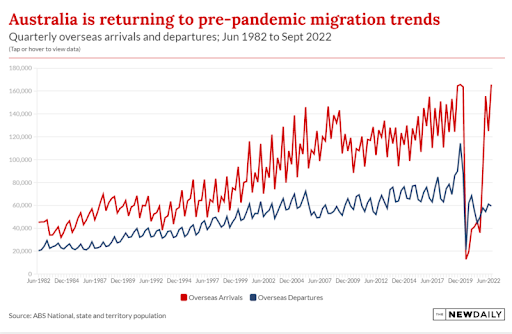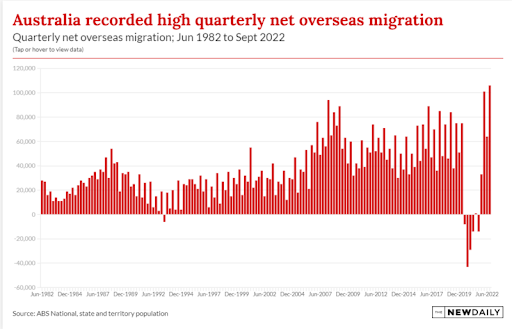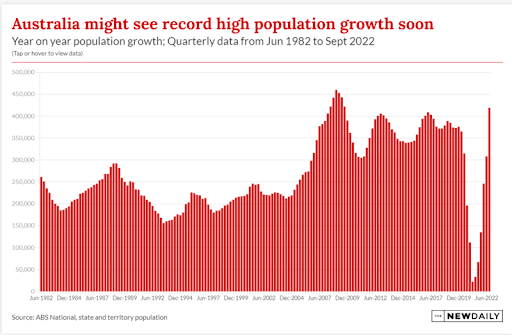
Australia reached a remarkable milestone, as of September 30, 2022, it was now home to 26,124,814 people.
The problem is the national population data gets published with about a six-month delay, but you can get more updated estimates at the Australian Population Clock which estimates that since then we have had:
- one birth every 1 minute and 43 seconds,
- one death every 3 minutes and 10 seconds,
- one person arriving to live in Australia every 44 seconds,
- one Australian resident leaving Australia to live overseas every 1 minute and 53 seconds, leading to
- an overall total population increase of one person every 55 seconds.
This significant growth can be attributed to a record-high net overseas migration intake in September, largely due to the pent-up demand following the COVID-19 pandemic.

Australia remains an attractive destination for international students and skilled workers, and as such, the country must focus on managing and channelling this growth effectively.
However, this rapid growth also presents numerous challenges that need to be addressed to ensure a sustainable and thriving future for the nation.
Record high migration intake
The pandemic led to a very low migration intake, with fewer international students and temporary workers in the country.
However, as border restrictions eased, overseas departure numbers remained relatively low, and many individuals who were unable to move during the border closures eventually migrated to Australia.

This resulted in record-high overseas arrival numbers in the September 2022 quarter.
Natural increase and population growth
Australia's population growth is not solely dependent on migration intake.
The natural increase, which is the surplus number of births relative to the number of deaths, also plays a role.
While birth rates have fallen over the years, the large Millennial cohort (born 1982-99) currently giving birth has kept the numbers stable.

However, with an all-time high in the number of deaths, the natural increase is falling, and soon, migration will contribute even more to the national population growth.
Managing growth and its impact
With population growth set to occur primarily near university campuses and Central Business Districts (CBDs) of major cities, it is crucial to manage this growth effectively.
Businesses and property owners in inner suburbs will benefit from the influx of international students and skilled workers, as they will contribute to the local economy and increase rental demand.
As I said at the outset, this rapid growth also presents numerous challenges that need to be addressed to ensure a sustainable and thriving future for our nation.
Challenge 1: Housing and affordability
One of the primary challenges arising from strong population growth is the increased demand for housing, which will drive up prices and exacerbate affordability issues.
All these migrants need accommodation – they don’t bring homes with them.
And currently, we have a shortage of houses for sale as well as a rental crisis with vacancy rates at historic lows and asking rentals skyrocketing.
And there is no end in sight as there a very few large-scale developments coming out of the ground because currently, they are not financially feasible.
In fact, very few new large-scale developments will commence until property values increase significantly making the developer take a speculative risk.
All this means that it is essential for the relevant ministers to collaborate and ensure that the right types of jobs, housing, and infrastructure are in place to accommodate the growing population.
Solution: Policymakers must prioritize affordable housing development in areas with high population growth, ensuring that new arrivals can find suitable accommodations.
Additionally, better coordination between migration and housing policies can help in the planning and development of housing projects aligned with the expected growth in specific regions.
Challenge 2: Infrastructure and public services
With a growing population comes increased pressure on infrastructure and public services, such as transportation, healthcare, education, and utilities.
Currently, our healthcare system is having difficulty coping, and it will only get worse as our population ages.
Similarly, our education system will struggle to accommodate the influx of new students, resulting in overcrowded schools, and our roads will become even more congested.
Solution: Government and local authorities should invest in infrastructure development projects that cater to the needs of the growing population. This includes expanding public transportation systems, constructing new schools and healthcare facilities, and upgrading utilities to accommodate increased demand.
Challenge 3: Environmental Sustainability
Population growth inevitably puts a strain on the environment, with higher demand for resources, increased waste production, and greater greenhouse gas emissions.
This can lead to issues such as deforestation, pollution, and climate change, all of which can have detrimental effects on Australia's unique ecosystems and biodiversity.
Solution: Promoting sustainable development practices and implementing strict environmental regulations can help mitigate the impact of population growth on the environment.
Encouraging the use of renewable energy sources, promoting public transportation, and supporting waste reduction initiatives can contribute to a more sustainable future for Australia.
Challenge 4: Social Cohesion and Integration
As migration contributes significantly to Australia's population growth, it is crucial to address the challenges related to social cohesion and integration.
Newcomers may face language barriers, cultural differences, and potential discrimination, which can hinder their ability to fully participate in society.
Solution: Implementing multicultural policies and programs that promote inclusivity and diversity can help foster a sense of belonging among new arrivals.
Language courses, cultural exchange programs, and community events can facilitate integration and encourage social cohesion.
Conclusion
Embracing high migration as a means to manage Australia's ageing population is a viable approach, but it must be executed carefully.
Australia's strong population growth presents major economic benefits but also significant challenges that must be addressed to ensure a prosperous and sustainable future for our nation.
By tackling issues related to housing, infrastructure, environmental sustainability, and social cohesion, Australia can navigate these challenges and continue to thrive as a diverse and vibrant country.
Fostering collaboration between policymakers, businesses, and communities is essential for developing and implementing effective strategies to overcome the hurdles presented by rapid population growth.
The concept for this article and the charts came from leading demographer Simon Kuestenmacher’s article in The New Daily
